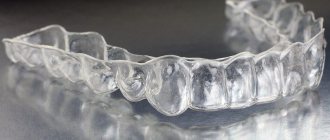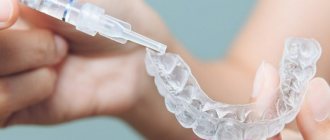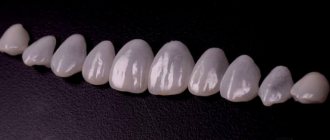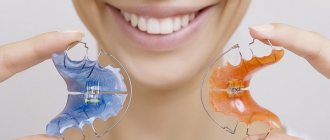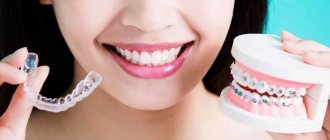July 15, 2021
In the process of correcting malocclusion with braces, some patients require additional elements to be installed on their teeth. Most often, elastics are fixed, which do not look as attractive and unnoticeable as we would like. Plus, some admit that with rubber bands they have to go through a new series of unpleasant sensations. What is this? How long? What are the features of installation and operation? What should you pay attention to? We'll talk about this in an article on the UltraSmile.ru portal.
What are elastics
Elastics, or as they are also called, rods for braces, are auxiliary devices, the purpose of which is to increase the impact on a specific tooth or group of teeth, to align the elements of the upper and lower jaw relative to each other. And thereby achieve an ideal result not only aesthetically, but also functionally. They look like ordinary small round rubber bands. Can be colored or transparent. Made from durable yet highly stretchable surgical latex.
Elastics are small round rubber bands made from durable but highly stretchable surgical latex.
It is important to understand that pulls are not the same as ligatures, although they are similar in appearance. The second, that is, ligatures, are an integral part of the ligature bracket system, where a metal power arc is attached to the grooves using ligatures (small rubber bands). They must be worn throughout the entire treatment period, and the doctor changes them every 2-4 weeks. But with elastic cords for braces, the situation is somewhat different.
What functions do rubber bands perform?
Like other additional devices, they can be used at different periods of bite correction , depending on the type and severity of the dental defect. With the help of elastic rods, the specialist directs the dentition to the calculated treatment trajectory and is able to control the movement of the jaws.
Very often they have to be worn in the interval between removing the system and switching to wearing a removable retainer. During this time, teeth should not be allowed to move from new positions. Therefore, buttons are attached to them, onto which hypoallergenic rubber bands are put on, which fix the position of the teeth and attract the jaws to each other.
Such a “surprise” can cause serious nervous shock in an adult who has spent several years straightening his teeth and is ready to start a new life with a perfect Hollywood smile. When you finally stop being embarrassed by braces and no longer have complexes about your appearance, elastics again cause serious psychological discomfort. But they do their job perfectly, and beauty, as you know, requires sacrifice or, at least, patience.
Therefore, it is so important to initially understand the details of each stage in order to plan your life in accordance with your goal, get used to the need to limit yourself and in no case become discouraged during treatment.
Indications for installation
- the presence of impacted teeth and the need to pull them into the dentition after freeing up additional space in the jaw,
- the need to align the jaws relative to each other or pull the upper jaw towards the lower so that they close normally (for example, with an open bite),
- the presence of a tooth protruding from the row: then it needs to be displaced,
- single interdental spaces, lack of contact between row elements.
Elastics have a constant impact on an individual tooth or group of teeth and, in fact, perform the same function as a power arc, but only more precisely and purposefully.
Elastics have a permanent effect on an individual tooth or group of teeth.
Why are rubber bands placed on braces?
After installing braces, orthodontists resort to various additional devices aimed at improving treatment results. These include special orthodontic traction bands or elastic bands. They are made from hypoallergenic material with high strength and elasticity.
On a note!
Essentially, these are rings of different diameters that are installed on separate areas of braces and used as dental traction.
In orthodontics, there are several types of rubber bands for braces, each of which has its own functions. Together, they help speed up the process of correcting existing anomalies of the dentofacial apparatus by performing the following tasks:
- enhancing the therapeutic effect on the dentition;
- additional load on problem areas;
- guarantee of reliable fixation of the arch to the braces;
- reducing the time required to correct incorrect teeth position.
Elastic rings or rubber bands help the orthodontist have complete control over the bite alignment process.
Types of traction
Today, braces manufacturers create elastics that differ in the following characteristics:
- elasticity, hardness: weak, medium, medium-strong, strong, super strong,
- length: short ones connect small areas, long ones connect groups of teeth,
- extraoral and intraoral: the former are used to treat mesial occlusion in combination with a facebow, the latter are used specifically for aligning elements in the oral cavity (most often they are what we are talking about).
To make it easier for doctors, and subsequently patients, to navigate the varieties, manufacturers produce rods in packages with the names of different animals or countries. Thus, the well-known company Ormco, which creates braces of the Damon series, produces a series of intermaxillary rods “Zoo”, where there are sets of “beaver”, “bull”, “camel”, “giraffe”, “penguin”, “ostrich” and others .
Damon series braces
Where to buy and cost of rubber bands
Rubber bands made of elastic materials in orthodontics belong to the class of consumables, so their price is affordable. When braces are first placed on teeth, the patient usually does not pay for them. For subsequent planned replacements of elastics, devices can be purchased directly from an orthodontist, a pharmacy or an online store.
The average cost of rubber bands for teeth in Moscow and St. Petersburg ranges from 60 to 150 rubles. A mirror may be included with the product, allowing you to conveniently replace elements recommended for self-removal and installation.
How to secure the rods
Initially, the installation of rods for braces is carried out by an orthodontist. He carefully threads them into special hooks located on the plates of the bracket systems. However, elastics can be fixed in the oral cavity in different ways:
- V-shaped: the elastic band is tightened on two teeth of one jaw and one element of a row of the other jaw. As a rule, it solves the issue of moving one unit, or helps to give two units a normal location relative to each other,
- box-shaped: after installation, the elastic takes on a square or rectangular shape. Responsible for moving and aligning an entire group of row elements.
Regardless of the installation method, elastics are always fixed on both jaws at once. Their location can be different: for example, they can connect the lower “sixes” and the upper “twos” or “fours”. In this case, a certain symmetry is always maintained due to the same tension force, which allows the load to be evenly distributed. Therefore, if one rubber band suddenly breaks, for example, on the right, then it is necessary to replace both rods.
After installation, the doctor must give you a special tool with a hook on the end and a “slingshot” on the other side, as well as a diagram of how to properly fix the elastic bands. After all, the patient will subsequently have to independently remove and put on the braces.
How to put on braces
Braces with elastic bands are combined with special hooks located on the plates. If we are talking about elastic rods, the doctor will tell you how to install them correctly and which structural elements they should cling to.
In other cases, the orthodontist himself must put elastic bands on the braces. He calculates in advance what the pressure force and tension of the braces should be, so that the elastics provide the necessary pressure force without the risk of injury to the teeth. They are worn symmetrically on both sides of the mouth. This is important for the proper functioning of the dentofacial apparatus and optimal correction of bite pathologies.
Important!
The installed rubber bands should not interfere with the opening of the mouth. If the procedure is performed professionally, the patient will not experience difficulties with swallowing and eating, and his diction will not be impaired.
How long to wear, when to take off
Depending on the period of operation, everything is very individual. Some patients wear elastics for 1-2 months, others for 4-6 months. But there are also those who go with them for more than six months.
The wearing pattern is also determined individually. At first, some people need to remove braces only when eating and for oral hygiene. Others wear them mainly at night, or for 12-16 hours a day.
“Oh, my elastics were installed in a zigzag pattern on the right and left. When it was first installed, I felt terrible pressure, especially at night. It even seemed as if the teeth were grinding, they were pulled together so tightly. And then I didn’t notice how I got used to it. The elastic bands stretch very quickly, and then you don’t even notice! I even tried to eat in them later, but I don’t recommend it to others, it could cause them to burst...” Masyanya, review from the forum breketi.3bb.ru
The pattern of wearing elastics is determined individually
How to use it correctly?
Despite the fact that elastic bands are an auxiliary material, do not underestimate their benefits and neglect the wearing rules. They are the ones who create the correct direction for teeth correction and help achieve an ideal bite, so do not forget to check with your doctor all the nuances of using pull rods and strictly follow them.
Rules for wearing elastics:
- Elastic bands for braces are used around the clock; they can only be removed when brushing your teeth,
- you should not move them yourself, trying to relieve the pressure,
- do not eat crackers, nuts and other hard foods - they will accelerate the wear of the rubber bands,
- always have a spare pack of elastics with you,
- If you no longer feel the tension, consult your doctor so that he can select other traction.
READ ALSO: What to do if your teeth hurt from braces?
Getting used to wearing elastic bands occurs within a few days. Therefore, if you experience discomfort in the first 2-3 days, you should be patient. Do not perform any independent actions with elastics and braces immediately after you have just started wearing them. This can lead to undesirable consequences, which will have to be corrected again at an appointment with the dentist.
INTERESTING: “Damon Q” braces: description of the design with photos
What inconveniences should you prepare yourself for?
You won't be able to chew food while wearing elastics, so you'll have to take them off for snacks. Moreover, if they are installed correctly, the patient usually does not have serious problems opening his mouth when speaking. But at first, many people, of course, feel discomfort from the new state of things in the mouth, soreness, and tightness.
Some patients admit: at first it seems that in this form and with their jaws pulled together it will be impossible to go to work, communicate with colleagues and friends. But in reality everything is different. Most quickly get used to it and feel quite at ease.
The rods for braces have one feature - they stretch quickly and therefore can fly off. Sometimes they also tear. So that they fully perform their function, and you “suffer” for good reason, be sure to change them. Doctors usually recommend replacing 2 times a day, morning and evening. Therefore, you need to always have a set of rubber bands at home. But there are usually no problems with stocks, because elastics are sold in sets of 100 pieces and are quite inexpensive.
You should not increase or decrease the number of elastic bands. There is no need to attach them to other areas unless prescribed by the orthodontist. Strictly follow all recommendations prescribed by your doctor, do not despair at the initial stage of possible discomfort and do not relieve cravings. And then a positive result will not be long in coming.
Notice
: Undefined variable: post_id in
/home/c/ch75405/public_html/wp-content/themes/UltraSmile/single-item.php
on line
45 Notice
: Undefined variable: full in
/home/c/ch75405/public_html/wp-content /themes/UltraSmile/single-item.php
on line
46
Rate this article:
( 2 ratings, average: 5.00 out of 5)
- According to the official website ormco.ru
Expert “In terms of size, the elastics seem very small, and in terms of elasticity, they seem too elastic. And many patients are perplexed about how they will put traction on braces. However, in reality, everyone eventually learns this too. A couple of attempts in front of the mirror, and then the desired skill appears, and the rubber bands are fixed in literally 2-3 minutes. A special tool helps a lot in quick fixation.” Orthodontist Vagapov Zakir Irkinovich
Consulting specialist
Vagapov Zakir Irkinovich
Doctor rating: 7 out of 10 (3) Specialization: Orthodontist Experience: 16 years




